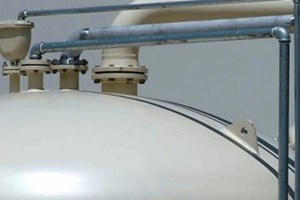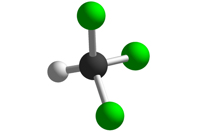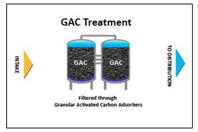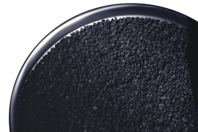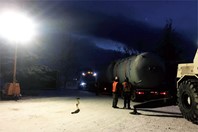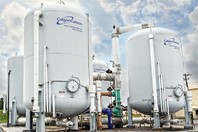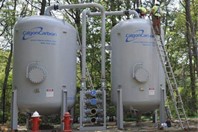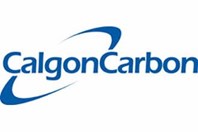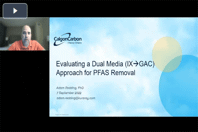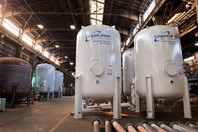ABOUT CALGON CARBON CORPORATION
Calgon Carbon a wholly-owned subsidiary of Kuraray Co., Ltd. (TYO: 3405) (Kuraray), is a global leader in the manufacture and/or distribution of innovative coal-, wood-, and coconut-based activated carbon products – in granular, powdered, pelletized, and cloth form – to meet the most challenging purification demands of customers throughout the world. In addition, Calgon Carbon offers highly engineered on-site equipment vessels and ion exchange equipment, as well as best in class services, enabling customers to take advantage of turnkey purification solutions. With more than 700 distinct applications, including drinking water, wastewater, pollution abatement, and a variety of industrial and commercial manufacturing processes, Calgon Carbon has been in business for 80 years. Headquartered in Pittsburgh, Pennsylvania, Calgon Carbon employs approximately 1660 people and operates 20 manufacturing, reactivation, innovation and equipment fabrication facilities in the U.S., Asia, and in Europe, where Calgon Carbon is known as Chemviron. Calgon Carbon was acquired by Kuraray in March of 2018. With complementary products and services, the combined organization will continue to focus on providing the highest quality and most innovative activated carbon and filtration media products, equipment, and services.
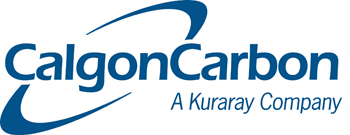
CONTACT INFORMATION
Calgon Carbon Corporation
3000 GSK Drive
Moon Township, PA 15108
UNITED STATES
Phone: 800.422.7266
Contact: Info@CalgonCarbon.com
FEATURED ARTICLES
-
This introduction to volatile organic compounds (VOCs) will discuss what qualifies a compound as a VOC, how to detect them, and how to treat and remove these chemicals from the water system.
-
Water treatment plants (WTPs) need to lean less on the disinfection process strategies (i.e., chloramination) and instead focus on more comprehensive DBP solutions such as removing TOC. Here's why.
-
Whether a water treatment plant (WTP) is evaluating a new granular activated carbon (GAC) solution to deal with contamination problems such as PFAS, DBPs, and VOCs or looking to enhance existing GAC performance, it is important to assess treatment processes in the full context of source water quality. Here are some ideas to help decision-makers achieve the best outcomes at the lowest total lifecycle cost.
-
Here are some considerations that can help water treatment plant (WTP) supervisors, operators, and their consulting engineers achieve their PFAS removal goals more efficiently and cost effectively despite the added challenges.
-
While activated carbon has garnered a lot of attention for its efficacy in removing per- and polyfluoroalkyl (PFAS) compounds from drinking water, it had a history in water treatment long before PFAS entered the public consciousness. Water Online spoke with Eli Townsend, applications engineer at Calgon Carbon, to discuss some non-PFAS challenges — e.g., taste and odor — and how water treatment plants (WTPs) can use activated carbon to solve them.
-
PFAS is a growing problem for municipal water utilities. The contaminant continues to show up in more water sources and regulations are a moving target that will likely involve more compounds and lower acceptable limits. As a result, crafting a long-term strategy to address PFAS can be problematic. However, those utilities using conventional gravity filters with anthracite as the filtering media have an opportunity to continue organic removal while adding PFAS removal with a simple conversion.
-
A collaborative pilot-scale study of two granular activated carbons, reagglomerated bituminous and sub-bituminous, was conducted to compare GAC PFAS removal performance to two ion exchange medias, macro-type and gel-type. Pilot results were used to generate a cost-comparison of medias to guide the future technology selection of the utility.
-
PFAS is increasingly an issue for drinking water utilities. While regulations are a moving target — with a push for testing that includes more compounds and lower detection limits — more utilities are deciding to treat their source water. As treatment evolves, so do the means and methods of disposing spent material, which changes the cost comparison for two key technologies.
-
Activated carbon technology is increasingly being deployed by wastewater and industrial plant operators across North America to remove PFAS compounds. However, the persistent nature of these contaminants, along with the unique challenges of the applications, can make the disposal of spent activated carbon a complex and important consideration. As a result, more operators are considering reactivation of spent activated carbon as a portion of their PFAS control strategy.
-
Removing total organic carbon (TOC) from drinking water is often a tricky proposition for municipal utilities that rely on surface water sources. Disinfection byproduct rules call for a percentage of removal instead of allowing a maximum contaminant level. Granular activated carbon is a cost-effective way to provide stability in TOC reduction for surface water sources and improve the quality of water in the distribution system.
-
For drinking water plant managers, granular activated carbon (GAC) is an effective technology for both treating and preventing the contaminant. However, powdered activated carbon (PAC) can offer a less costly alternative that makes better sense in some scenarios.
-
When adsorption systems are optimally designed for drinking water treatment, municipalities reap tremendous rewards, including the flexibility to address changing requirements and long-term operational cost savings. The problem is that water utilities often miss this opportunity by calculating the activated carbon capacity for a system but failing to specify the proper equipment.
-
When Eielson Air Force Base, located in the interior of Alaska, found high levels of perfluorooctanoic acid (PFOA) and perfluorooctane sulfonate (PFOS) in their drinking water, they needed a solution that was effective, cost-efficient, and operable in extreme temperatures. Calgon Carbon’s Model 10 adsorption system, filled with FILTRASORB 400 granular activated carbon (GAC), was determined to be the best option.
-
Discover how a small town in Delaware addressed PFAS that were detected in three public wells, impacting more than 1,250 residents and businesses.
-
Nestled in the Finger Lakes region in upstate New York, the town of Owasco is a popular vacation spot. With about 4,000 residents, the town, along with the nearby community of Auburn, relies on Owasco Lake for its drinking water. In 2016, Owasco and Auburn detected algal toxins in their finished water for the first time. With the busy summer tourist season quickly approaching, GHD contacted Calgon Carbon.
-
In 2010, Shelby County Water Services (SCWS) was planning for the future. With new regulations on the horizon, SCWS determined that the Talladega/Shelby water treatment plant in Shelby County, AL, needed more effective removal of disinfection byproducts (DBPs). Specifically, the treatment plant needed help complying with the U.S. EPA’s new Stage 2 Disinfection Byproduct Rule (DBPR).
-
Water utilities must protect the public health by producing a final product that meets all regulatory requirements. In addition, the water must be pleasing to the customer, with no taste or odor issues. And finally, utilities must stay abreast of emerging contaminants, health advisories, and new regulations. It’s a constant challenge to shoulder these responsibilities while staying within tight budgets. Utilities need a technology that helps them achieve multiple goals cost-effectively.
-
Protecting the public health and ensuring water is safe to drink is the highest goal of water system managers. Negative health effects are indicated from exposure to per- and polyfluoroalkyl substances (PFAS), such as perfluorooctanoic acid (PFOA) and perfluorooctyl sulfonate (PFOS). Based on lab studies, the U.S. EPA has issued a health advisory for PFOA and PFOS in drinking water of 70 parts per trillion. While health advisories are not enforceable, they offer a margin of safety for consumers.
-
Water professionals must plan and budget to meet new regulations on the horizon. They must find the best technology for removing emerging contaminants, such as perfluorinated compounds. Above all, they want to ensure the health and safety of their customers.
-
Staying on top of new regulations is a never-ending responsibility for water professionals. Each new rule may require huge dollars in capital and operating costs. Operators and technicians may need training on new technologies, sampling, and testing methods.
-
Industrial wastewater operations have to tangle with myriad regulations and countless contaminants every day, making their work some of the most complicated that the treatment sector has to offer. Wrapping one’s head around these challenges can be difficult, but finding the solutions for them can be near impossible. Luckily, there’s an age-old technology that continues to offer industrial wastewater treatment operators salvation.
-
Water utility managers have a lot of responsibilities, not the least of which is to keep up with the latest in the industry—especially contaminants like PFAS. Water Online spoke with Calgon Carbon about these important emerging contaminants and how best to remove them.
-
After a small village on the border of Vermont tested positive for PFOA in the municipal drinking water, they solicited the services of engineering firm CT Male Associates to investigate treatment options and provide a treatment system.
-
What is 1, 2, 3 - TCP? 1, 2, 3 - TCP is a man-made, colorless, chlorinated hydrocarbon that is used as a degreasing and cleaning agent and industrial solvent. It was also used as a chemical in pesticides for low growing crops such as potatoes, tobacco, and beets. 1, 2, 3 - TCP passes through soil and leaches into ground water, contaminating drinking water sources. 1, 2, 3 - TCP is a non-aqueous liquid that is more dense than water, making it difficult to remove from ground water wells. This compound is currently unregulated by the USEPA, although it is on the Contaminant Candidate List 4 (CCL4) for future regulation.
-
Read about a stack testing program at a full-scale GAC reactivation facility during the reactivation of a load of GAC known to contain adsorbed PFAS.
-
The U.S. EPA recently announced its proposal for what would be the first-ever national drinking water standards for PFAS. This news likely triggered several questions about what this means to the drinking water industry. Here, we will address some of the most important ones.
-
Learn how naturally occurring biological growth on carbon media can help enhance removal of total organic carbon (TOC) and thusly reduce the formation of DBPs.
-
In this segment from Virtual Water Expo, Dr. Adam Redding discusses a dual media (IX/GAC) approach for PFAS removal.
-
Water treatment plants (WTPs) that deciding between ion exchange (IX) or granular activated carbon (GAC) systems should weigh the operation and maintenance of each before implementing either technology.
-
De Nora, a global leader in the delivery of sustainable technologies, has today announced the acquisition of the UV Technologies Division (“CCUV”) from Calgon Carbon Corporation. The deal includes municipal and industrial water ultraviolet disinfection brands RAYOX, SENTINEL and C3 SERIES UV, as well as the products, brands and assets of Hyde Marine, a world leader in UV ballast water management systems.
-
Calgon Carbon Corporation today announced that it intends to expand capacity at its Pearlington, Mississippi plant by adding a second virgin activated carbon production line. The expansion is expected to add 38 jobs at the plant when complete.
-
As states and the federal government march toward PFAS regulation, it’s only a matter of time before most municipal water systems will be required to address the contaminant. And with the constantly changing patchwork of proposed regulations, meaning the earliest imposed rules will likely evolve, PFAS promises to be a moving target for a long time. Preparing now is the key to be in the best position to maintain compliance.
-
Granular activated carbon (GAC) is an effective and proven technology for the removal of PFAS and many other harmful organic compounds. But, not all products are the same and using the right GAC can make the difference between success and failure.
-
While municipalities have been working for several years to address per- and polyfluoroalkyl substances, commonly known as PFAS, a growing number of industrial operations are being prompted to treat their wastewater and stormwater for the contaminants. While any steps taken to reduce PFAS are positive, performing a thorough investigation before selecting a solution is critical to getting the best results at the lowest cost.
-
Water utilities around the country are trying to get a handle on their PFAS problem. While the presence of legacy PFAS is well known, lesser understood replacements such as short-chain PFAS are emerging as a major issue. The short-chain compounds are particularly important because they can be more difficult to remove. In this Water Talk interview, Adam Redding, technical director for drinking water solutions for Calgon Carbon, discusses the science and economics behind effective solutions for treating water for short-chain PFAS and other contaminants.
-
Debate about regulating per- and polyfluoroalkyl substances is heating up across the country as the extent of known contamination continues to grow at an alarming rate. Also known as PFAS, this large group of toxic fluorinated compounds was used widely in industrial and consumer applications. Progressive water utilities are trying to quickly get a handle on the problem to better protect their customers from even further exposure.
-
As technology improves, contaminants can be measured in ever-smaller quantities. Pollutants formerly undetected are now becoming emerging contaminants of concern. Water utility managers must stay abreast of potential new regulations and plan for ways to address these contaminants.
-
Most industries are required to remove contaminants from wastewater systems before discharge to a receiving stream or municipal facility. Depending on the industry, contaminants may be numerous or difficult to treat. Finding the most effective, cost-efficient treatment method is critical for both business and the environment.
-
As our ability to measure contaminants at ever smaller concentrations improves, “emerging contaminants” are on the rise. Per the U.S. Environmental Protection Agency (EPA), emerging contaminants are chemicals or materials characterized by a perceived, potential, or real threat to human health or the environment.
-
When the Cobb County-Marietta Water Authority (CCMWA) anticipated the need to upgrade the Hugh A. Wyckoff water treatment plant, they turned to granular activated carbon (GAC) technology after vetting several alternatives. The plant, a wholesaler in a two-plant system, processes up to 72 million gallons per day and serves about 350,000 people. Comprising of Wyckoff and the James E. Quarles treatment plant, CCMWA is the second largest water provider in Georgia.







